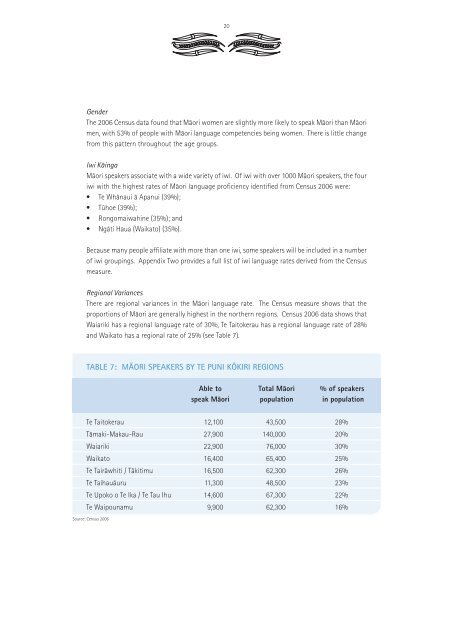The Health of the Maori Language in 2006 - Te Puni Kokiri
The Health of the Maori Language in 2006 - Te Puni Kokiri
The Health of the Maori Language in 2006 - Te Puni Kokiri
You also want an ePaper? Increase the reach of your titles
YUMPU automatically turns print PDFs into web optimized ePapers that Google loves.
20<br />
Gender<br />
<strong>The</strong> <strong>2006</strong> Census data found that Mäori women are slightly more likely to speak Mäori than Mäori<br />
men, with 53% <strong>of</strong> people with Mäori language competencies be<strong>in</strong>g women. <strong>The</strong>re is little change<br />
from this pattern throughout <strong>the</strong> age groups.<br />
Iwi Kä<strong>in</strong>ga<br />
Mäori speakers associate with a wide variety <strong>of</strong> iwi. Of iwi with over 1000 Mäori speakers, <strong>the</strong> four<br />
iwi with <strong>the</strong> highest rates <strong>of</strong> Mäori language pr<strong>of</strong>iciency identified from Census <strong>2006</strong> were:<br />
• <strong>Te</strong> Whänaui ä Apanui (39%);<br />
• Tühoe (39%);<br />
• Rongomaiwah<strong>in</strong>e (35%); and<br />
• Ngäti Haua (Waikato) (35%).<br />
Because many people affiliate with more than one iwi, some speakers will be <strong>in</strong>cluded <strong>in</strong> a number<br />
<strong>of</strong> iwi group<strong>in</strong>gs. Appendix Two provides a full list <strong>of</strong> iwi language rates derived from <strong>the</strong> Census<br />
measure.<br />
Regional Variances<br />
<strong>The</strong>re are regional variances <strong>in</strong> <strong>the</strong> Mäori language rate. <strong>The</strong> Census measure shows that <strong>the</strong><br />
proportions <strong>of</strong> Mäori are generally highest <strong>in</strong> <strong>the</strong> nor<strong>the</strong>rn regions. Census <strong>2006</strong> data shows that<br />
Waiariki has a regional language rate <strong>of</strong> 30%, <strong>Te</strong> Taitokerau has a regional language rate <strong>of</strong> 28%<br />
and Waikato has a regional rate <strong>of</strong> 25% (see Table 7).<br />
TABLE 7: MÄORI SPEAKERS BY TE PUNI KÖKIRI REGIONS<br />
Able to Total Mäori % <strong>of</strong> speakers<br />
speak Mäori population <strong>in</strong> population<br />
<strong>Te</strong> Taitokerau 12,100 43,500 28%<br />
Tämaki-Makau-Rau 27,900 140,000 20%<br />
Waiariki 22,900 76,000 30%<br />
Waikato 16,400 65,400 25%<br />
<strong>Te</strong> Tairäwhiti / Täkitimu 16,500 62,300 26%<br />
<strong>Te</strong> Taihauäuru 11,300 48,500 23%<br />
<strong>Te</strong> Upoko o <strong>Te</strong> Ika / <strong>Te</strong> Tau Ihu 14,600 67,300 22%<br />
<strong>Te</strong> Waipounamu 9,900 62,300 16%<br />
Source: Census <strong>2006</strong>

















